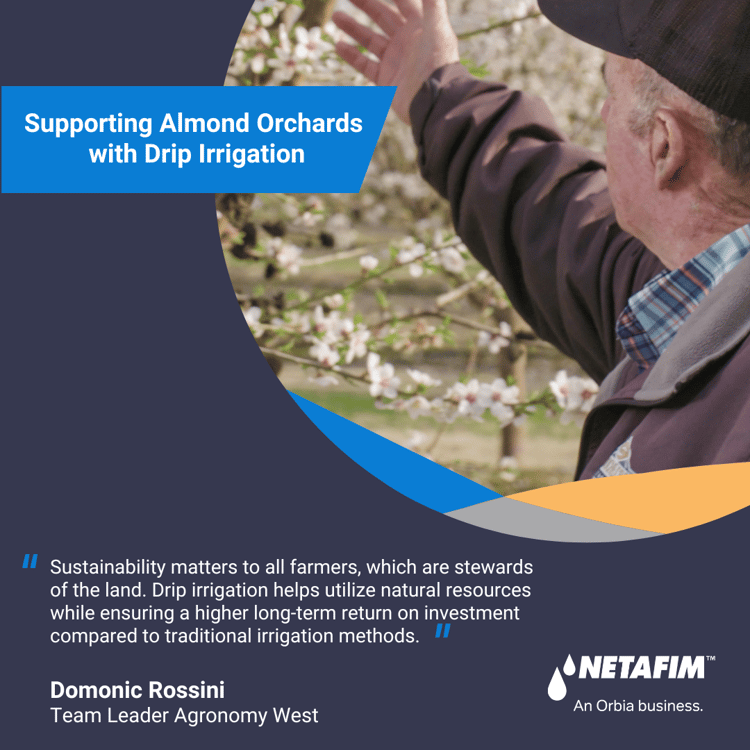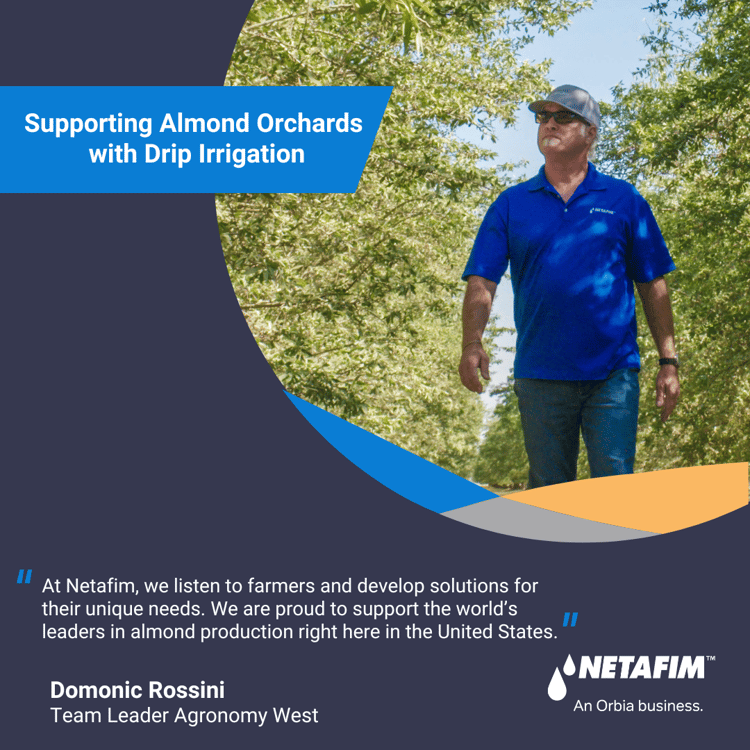Supporting Almond Orchards with Drip Irrigation
Long shelf life, rich nutrients, less fat, versatility, and a unique flavor. These are just a few factors that have made almonds among the most popular nuts in the market. The past 10 years have seen a 70% increase in the global production of shelled almonds, reaching an annual total of about 1.78 million metric tons.
California almonds make up over 80% of the total global production and are exported to 100 countries. Primarily, almonds are grown throughout the Central Valley and the Sacramento Valley, not far from our Netafim USA offices. Working closely with growers, Netafim has proudly supported the orchards with customized drip irrigation solutions, developed specifically for almond trees on the local soils for over 35 years.
How Drip Irrigation Benefits Water, Nutrients, and Soil
The Mediterranean climate in California provides ideal conditions for orchards to grow high-quality nuts. Hot and dry summers prevent mold, mildew, and diseases, while mild, humid winters allow the trees to rest and stock up on nutrients required for the next growing season.
However, this climate also brings one big challenge to almond orchards: irrigation. It’s every grower’s top priority to ensure the trees receive a proper amount of water and nutrients, which can be done through well-drained soil that will ideally be a loam-textured mix consisting of sand and clay. Drip irrigation and micro irrigation play a key role in this process: they efficiently deliver a proper mixture of water and fertilizers to the feeder roots, a crucial step that requires careful management throughout the tree’s lifespan. By configuring the ideal ratio of water and various fertilizers in the irrigation systems, drip irrigation helps almond trees stay hydrated while breathing and absorbing the necessary elements for a healthy diet.

Additional Benefits of Drip Irrigation
In addition to water management, fertilizer control, and soil protection, the application of drip irrigation systems provides other benefits helpful for optimizing almond production.
For example, a typical harvest period requires about seven days for fresh almond nuts to dry out under normal heat conditions. Utilizing the natural environment, this is typically done by placing the nuts on the ground until they are collected. Unlike traditional methods that risk soaking the nuts with unnecessary amounts of water, drip irrigation delivers water directly to tree roots while not adding humidity as the nuts dry on the ground level. This strikes a balance between harvesting and plant maintenance. Assisting in increasing, as well as more consistent yields.
Drip irrigation also facilitates multitasking in the orchard. Imagine an orchard equipped with a standard sprinkler or flood system: when it’s turned on, workers are unable to enter the floor of the orchard. In comparison, a drip irrigation system can be operating while personnel can access the orchard floor. This allows the tree to be healthier while different operations can take place in the orchard like spraying, training, and pruning.
Sub-surface drip irrigation systems also help save on maintenance costs by avoiding any potential mechanical damage caused by machines, mice, coyotes, and/or birds. Take Netafim’s Uniram XRS as an example: After listening to growers Netafim developed this product as the only direct-burial heavy wall drip line on the market. It stays out of the way of heavy machines, as well as animals, which therefore eliminates the hassle of fixing damages they would otherwise have caused to other systems. With Cupron Copper Oxide embedded into the stripe and emitter, Uniram XRS does more than irrigation: the subsurface driplines also help prevent clogging and root intrusion, by keeping the trees well-grounded, acting as a framework that guides the roots.

Improving ROI in the Orchard
Sustainability matters to all farmers which are stewards of the land. Drip irrigation helps utilize natural resources while ensuring a higher long-term return on investment compared to traditional irrigation methods.
Over the years, we’ve heard many stories of farmers going from flood to sprinklers and micro-sprinklers, and eventually upgrading to dual-line drip or hybrid irrigation systems. The initial investment goes a long way: under proper maintenance, Uniram XRS drip lines can last 20-30 years, covering the entire lifespan of most almond trees. One farmer shared with us how Netafim’s dual-line system resulted in a 25% decrease in water usage, and a 10-15% increase in production. With the help of filtration systems like Screenguard, farmers can even save more by controlling the amount of water and nutrients like nitrogen, potash, and sulfur.
At Netafim, we listen to farmers and develop solutions for their unique needs. We are proud to support the world’s leaders in almond production right here in the United States.
Watch our Almond video, where we follow a group of California almond farmers over the span of 1 year and documented their stories.



Comments
We'd love to hear your thoughts! To enter a comment, type your name and email address.